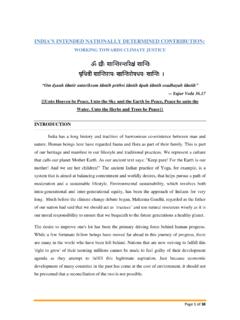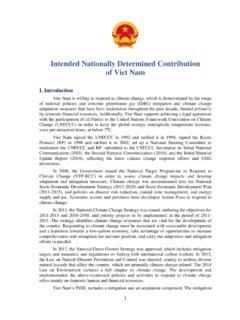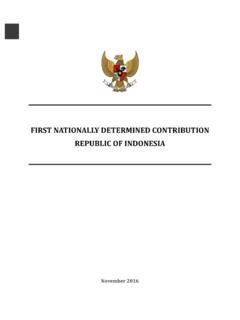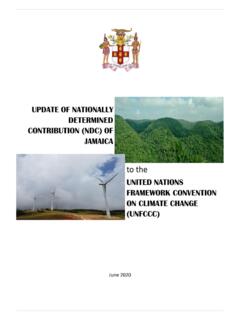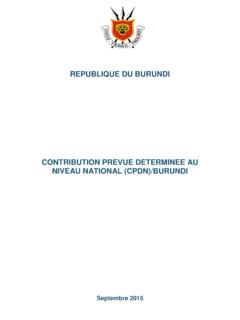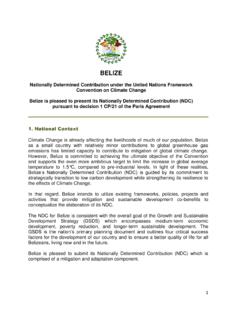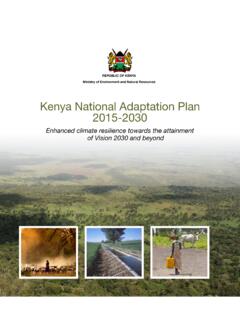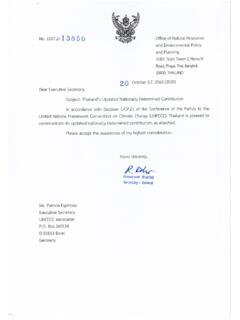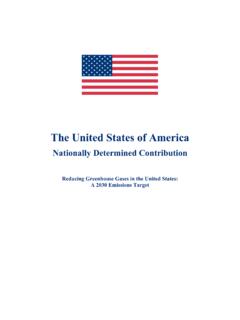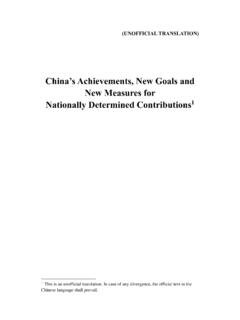Transcription of Nationally Determined Contribution (NDC)
1 Lao People's Democratic Republic Peace Independence Democracy Unity Prosperity Nationally Determined Contribution (NDC). 09 March 2021. Table of Contents 1. INTRODUCTION .. 1. 2. MITIGATION .. 2. National context .. 2. Summary of the scenario analysis .. 3. Baseline scenario .. 3. Estimated national GHG emissions in 2020 and NDC implementation 3. 2030 Unconditional mitigation scenario and targets .. 4. 2030 Conditional mitigation scenario and targets towards net zero emissions 2050 .. 6. Country needs .. 7. Methodology .. 8. 3. ADAPTATION .. 9. National context .. 9. Current and near-term planning and actions .. 10. Gaps, barriers and needs .. 13. 4. IMPLEMENTATION .. 15. National Coordination 15. Monitoring and Evaluation .. 16. Voluntary International cooperation .. 16. ANNEX 1: Mitigation Measures .. 17. Unconditional 17.
2 Conditional measures .. 18. ANNEX 2: Adaptation Measures .. 22. Health Adaptation Strategy Summary of components and indicators .. 22. Indicators and targets for the Water Supply, Sanitation and Hygiene' project .. 23. 1. INTRODUCTION. Lao People's Democratic Republic herewith presents its 2020 updated and enhanced Nationally Determined Contribution , in accordance with decision 1 of the Conference of the Parties and following the country's intended Nationally Determined Contribution (INDC) to the objectives of the Paris Agreement submitted to the UNFCCC on September 30th, 2015, and ratified by the Government on September 7th, 2016. As per Paris Agreement Article 4, the 2020 NDC update builds upon the 2015 submission with a view to enhancing its ambition through the introduction of three national level greenhouse gas (GHG).
3 Emissions scenarios, namely a baseline emissions scenario, an unconditional mitigation scenario to 2030, as well as a more ambitious conditional mitigation scenario to 2030 towards achieving net zero GHG. emissions by 2050. 2015 NDC targets have been updated and extended, including to new sectors, while new national level emission reductions targets have been formulated. The 2020 NDC also sets forth increased transparency and consistency between quantitative targets, new short-term objectives for climate change adaptation towards a strengthened measurement, reporting and verification system, as well as the country's expression of interest to pursue voluntary cooperation to allow for higher ambition, in accordance with the Paris Agreement. With this new submission, the Government of Lao PDR intends to report on the progress of the country's Contribution to the objectives of the Paris Agreement, and to bring forward enhanced action with the aim of strengthening Lao PDR's response to the threat of climate change while reflecting its common but differentiated responsibility and respective capability in a fair and ambitious manner, in light of the country's Least Developed Country (LDC) status and very limited Contribution to global GHG emission levels.
4 The long-term vision on how to address climate change will not be reiterated while only significant evolutions in the national circumstances will be elaborated upon. All mitigation and adaptation measures in the 2020 NDC contribute to the Paris Agreement, including but not limited to holding the increase in the global average temperature to well below 2 C above pre- industrial levels and pursuing efforts to limit the temperature increase to C above pre-industrial levels , as well as increasing the ability to adapt to the adverse impacts of climate change . Proposed interventions will also serve the country's post COVID-19 economic recovery by increasing resilience and accelerating decarbonization. The 2020 NDC is aligned with the country's Sustainable Development Goals to be set out in the 9th five-year National Socio-Economic Development Plan (2021- 2025), with a focus on combating climate change and its impacts.
5 This document has been subject to four formal rounds of consultation with stakeholders, including Government agencies, development partners, as well as public and private actors. At the end of 2019. an assessment of the progress for each target set out in the 2015 NDC was undertaken. This also provided an opportunity to get an update on the current situation and near-term future planning. The second and third rounds between April and August 2020 aimed to receive comprehensive feedback and comments from all relevant stakeholders on the draft NDC. The last round of consultation was conducted as part of the final validation workshop. Participation of the private sector will be instrumental in the implementation of the NDC and shall be facilitated through adequate policies for licensing and regulations for investment at sectoral level.
6 1. 2. MITIGATION. National context Complementing existing national level policy framework (2015 NDC), the Prime Minister's Office issued on September 19th, 2019, the Decree on Climate Change which defines principles, regulations, and measures on management, monitoring of climate matters. Simultaneously, the Decree states that climate change must be mainstreamed into the national socio-economic development plans, sectoral as well as local strategies and plans. As per the Second National Communication to the UNFCCC in June 2013, total emissions of greenhouse gases in Lao PDR amounted to 50, ktCO2e1 in year 2000, with Land Use Change &. Forestry (LUCF) and Agriculture responsible for over 95% of the total. Emission drivers such as economic and population growth increased by and per year respectively between 2000 and 2018.
7 Besides, the total number of vehicles registered in the country grew drastically from 367,900 in year 2004 to 2,133,500 in year 2017 (+480%), while transport fuel consumption grew from 855 million liters in 2013 to 1,442 Million liters in 2016. The following four sections provide the results of the scenario analysis undertaken for the 2020 NDC. update as part of the country's enhanced ambition. Three scenarios are developed: A baseline scenario which is a reference case that illustrates future GHG emission levels most likely to occur in the absence of GHG mitigation activities. An unconditional mitigation scenario that reflects GHG emission reductions efforts that Lao PDR. can commit to, considering own resources and existing levels of support from developed country Parties. A conditional mitigation scenario that represents additional GHG emission reductions efforts that Lao PDR could achieve, contingent upon increased levels of financial support from developed country Parties.
8 Section is a graph summary of all scenarios. Section provides background information about the baseline scenario. Section estimates 2020 emissions level and discusses the country's progress against the mitigation targets set out in the 2015 NDC. Section introduces the 2030 unconditional mitigation scenario and associated updated targets. Section describes the 2030 conditional mitigation scenario and associated targets towards achieving net zero emissions by 2050. Sectors covered by the analysis include energy, industrial processes, agriculture, land-use change and forestry, and waste. Greenhouse gases comprise carbon dioxide (CO2), methane (CH4) and nitrous oxide (N2O). Emissions hydrofluorocarbons (HFCs), perfluorocarbons (PFCs), and sulfur hexafluoride (SF6) are considered negligible in Lao PDR and excluded from the analysis.
9 The boundaries of the analysis correspond to the national borders of the country. Year 2000 is selected as the base year for the calculations of all scenarios. 1. Kilotons of CO2 equivalent 2. Summary of the scenario analysis Figure 1 below provides an overview of GHG emissions from all sectors from the base year 2000. according to the 3 scenarios described above. The 2020 value on the unconditional 2030 scenario represents estimated current level of emissions. Post 2030 unconditional scenario will be communicated in future NDC submissions. Figure 1: GHG emissions scenarios from all sectors GHG emissions from all sectors 140,000. Baseline GHG emissions scenario (ktCO2e). 120,000. 100,000. Unconditional 2030 mitigation scenario (ktCO2e). 80,000. ktCO2/yr Post 2030 unconditional scenario to be 60,000 confirmed in future NDC (ktCO2e).
10 40,000. Conditional net zero 2050 scenario (ktCO2). 20,000. 0. 2000 2010 2020 2030 2040 2050. Baseline scenario The baseline scenario is a hypothetical or projected reference case that represents future GHG emission levels most likely to occur in the absence of GHG mitigation activities. This scenario is used to develop the unconditional and conditional mitigation goal scenarios and was computed through extrapolation of historical growth trends at sectoral scale (See also methodology section). Under the baseline scenario, total GHG emissions levels in Lao PDR would be expected to reach around 82,000 ktCO2e in 2020 and 104,000 ktCO2e in 2030. Detailed baseline projections to 2050 are presented in Figure 1 under section Main sectors expected to contribute to baseline emissions are LUFC, agriculture and energy, including transport and power sector, through the potential addition of base load coal-fired power generation.
